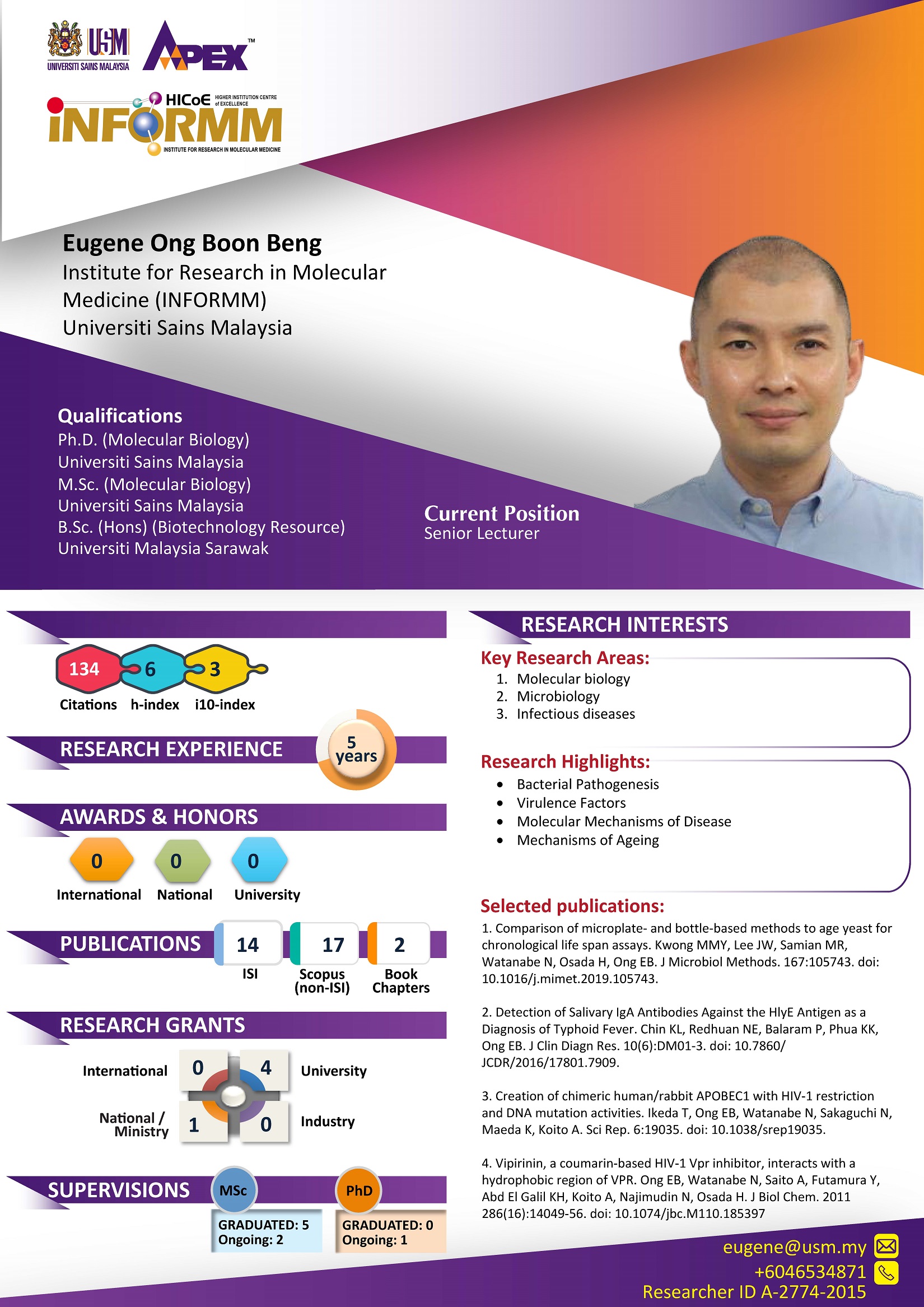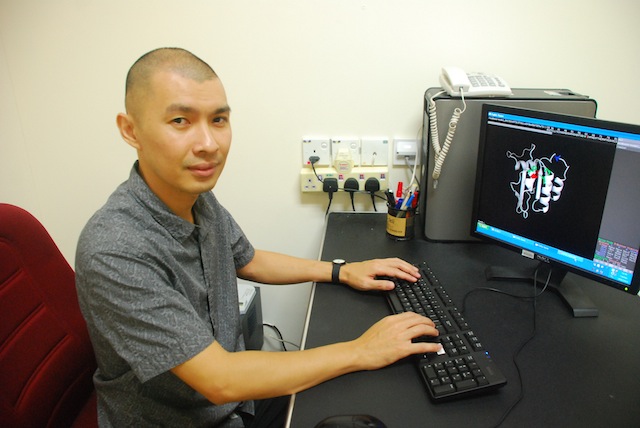Eugene Ong Boon Beng

Name
Eugene Ong Boon Beng
Current Position
Senior Lecturer
eugene@usm.my
Office Telephone
+604-6534871
Qualifications
BSc (Hons), Universiti Malaysia Sarawak, 2000
MSc, Universiti Sains Malaysia, 2005
PhD, Universiti Sains Malaysia, 2011
Affiliations
Visiting Research Associate Professor, University of Tokyo (Dec 2016 - Feb 2017)
Research Interests
bacterial pathogenesis, virulence factors, molecular mechanisms of disease, mechanisms of ageing
Research Overview 1
Understanding the molecular mechanisms of bacterial virulence factors
A common theme in bacterial pathogenesis is the secretion of bacterial virulence factors that can modify host cellular functions to evade host defense systems; these may be adhesion factors, invasions factors, endotoxins or exotoxins. To alter the host cell, bacterial virulence factors must reach their host target and the ability of bacterial proteins to gain access to the host cell cytoplasm is often a critical step in pathogenesis. In this aspect, processes such as type III, type IV and type VI secretion systems exist in pathogens. For example, the secretion of these virulence factors allow pathogens such as Salmonella Typhi to interact with host cells and create unique niches for replication and dissemination.
To understand the molecular mechanisms of these virulence factors we are using the well-studied model organism – Saccharomyces cerevisiae. The molecular biology of the single-celled budding yeast is well established and it is amenable to high-throughput systems. It also has a high degree of conservation of basic molecular and cellular mechanisms to human cells, making it a heterologous and cellular eukaryotic environment suitable for many fundamental studies.
We are currently studying virulence factors from Salmonella Typhi and Leptospira interrogans in this yeast system by using high-throughput cloning and protein expression systems followed by protein-protein interaction studies.
Research Overview 2
Molecular mechanisms of ageing in yeast
Ageing is a biological process involving many proteins and biochemical pathways. Among the many proteins involved, one particular ubiquitous group known as Cyclophilins (CyPs), have been the centre of attraction. It is a family of proteins that are evolutionarily well conserved and present in all prokaryotes and eukaryotes. Peptidyl-prolyl cis-trans isomerase A (also known as Cyclophilin A (CyPA) or Cyclosporin A-binding protein) is an ubiquitously distributed protein belonging to the immunophilin family. The CyPA protein is highly conserved and can be found in yeast, roundworm Caenorhabditis elegans, fruitfly Drosophila melanogaster and humans. CyPA has enzymatic activity that regulates protein folding and trafficking in the cell. Initially, CyPA was thought to only function intracellularly but recent studies showed that it can be secreted by cells in response to inflammatory stimuli.
In this study, we will study the yeast Cyclophilin A (CPR1) and other ageing-related proteins using the chronological life span assay. The well-characterized genome of yeast and the availability of many established molecular techniques make yeast a suitable model organism for studying pathways relevant to human ageing and diseases.
Selected Publications
1: Chin KL, Redhuan NE, Balaram P, Phua KK, Ong EB. Detection of Salivary IgA Antibodies Against the HlyE Antigen as a Diagnosis of Typhoid Fever. J Clin Diagn Res. 2016 Jun;10(6):DM01-3. doi: 10.7860/JCDR/2016/17801.7909. Epub 2016 Jun 1.PubMed PMID: 27504289; PubMed Central PMCID: PMC4963649.
2: Ikeda T, Ong EB, Watanabe N, Sakaguchi N, Maeda K, Koito A. Creation of chimeric human/rabbit APOBEC1 with HIV-1 restriction and DNA mutation activities. Sci Rep. 2016 Jan 7;6:19035. doi: 10.1038/srep19035. PubMed PMID: 26738439; PubMed Central PMCID: PMC4704027.
3: Choi SB, Choong YS, Saito A, Wahab HA, Najimudin N, Watanabe N, Osada H, Ong EB. In Silico Investigation of a HIV-1 Vpr Inhibitor Binding Site: Potential for Virtual Screening and anti-HIV Drug Design. Mol Inform. 2014 Dec;33(11-12):742-8. doi: 10.1002/minf.201400080. Epub 2014 Nov 25. PubMed PMID: 27485420.
4: Ong EB, Ignatius J, Anthony AA, Aziah I, Ismail A, Lim TS. Multi-isotype antibody responses against the multimeric Salmonella Typhi recombinant hemolysin E antigen. Microbiol Immunol. 2015 Jan;59(1):43-7. doi: 10.1111/1348-0421.12211. PubMed PMID: 25399538.
5: Chin CF, Teh BA, Anthony AA, Aziah I, Ismail A, Ong EB, Lim TS. Overexpression, purification and validation of antigenic Salmonella enterica serovar Typhi proteins identified from LC-MS/MS. Appl Biochem Biotechnol. 2014 Nov;174(5):1897-906. doi: 10.1007/s12010-014-1173-y. Epub 2014 Aug 23. PubMed PMID: 25149461.
6: Lau KL, Ong EB, Zainudin ZF, Samian MR, Ismail A, Najimudin N. Salmonella enterica serovar Typhi cutF is upregulated during environmental stress. J Gen Appl Microbiol. 2013;59(3):239-44. PubMed PMID: 23863294.
7: Ong EB, Anthony AA, Ismail A, Ismail A, Lim TS. Cloning, expression, and purification of the hemolysin/cytolysin (HlyE antigen) from Salmonella enterica serovar Typhi: potential application for immunoassay development. Diagn Microbiol Infect Dis. 2013 Sep;77(1):87-9. doi: 10.1016/j.diagmicrobio.2013.05.010. Epub 2013 Jun 20. PubMed PMID: 23790417.
8: Yuen CW, Ong EB, Mohamad S, Manaf UA, Najimudin N. Construction and characterization of a Burkholderia pseudomallei wzm deletion mutant. J Microbiol Biotechnol. 2012 Oct;22(10):1336-42. PubMed PMID: 23075783.
9: Ong EB, Watanabe N, Saito A, Futamura Y, Abd El Galil KH, Koito A, Najimudin N, Osada H. Vipirinin, a coumarin-based HIV-1 Vpr inhibitor, interacts with a hydrophobic region of VPR. J Biol Chem. 2011 Apr 22;286(16):14049-56. doi: 10.1074/jbc.M110.185397. Epub 2011 Feb 28. PubMed PMID: 21357691; PubMed Central PMCID: PMC3077605.
Author Links
Lab Website

